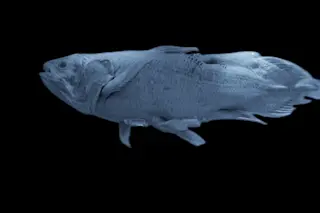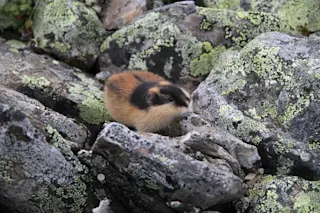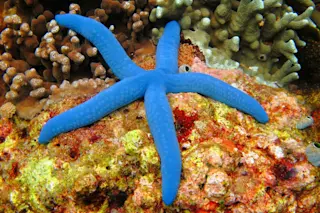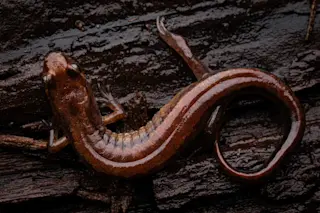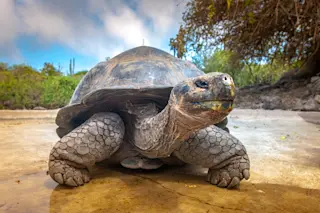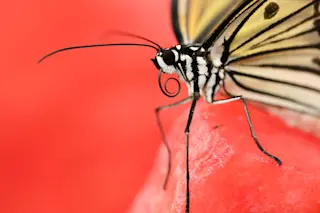This article was originally published on Sept. 6, 2022.
In 1873, the geologist Robert Stearns called attention to a single, fossilized tooth on the Channel Islands off the coast of southern California. Despite being considerably small, it bore the distinct ridges of a mammoth tooth — which weren’t known to be among the island’s repertoire of fauna.
By 1928, enough fossils had been found throughout the Channel Islands to make Stearns’ discovery the first of an entirely new species: Mammuthus exilis, or the pygmy mammoth. It’s an apt name for an animal that was abnormally tiny (for a mammoth), standing on average 5 feet 6 inches tall at the shoulder and about 10 times lighter than the larger Columbian mammoths that plodded the mainland.
These miniature mammoths weren’t known anywhere else in the world, despite bearing striking resemblance to the larger mammoths living in California. This raises the question: If the Channel Islands were never connected to the continent, how did these shrunken replicas of North America’s largest land mammal end up so far away? Furthermore, why were they so tiny?
The Miniature Mammoth as Surprising Seafarers
Their story starts during the late Pleistocene, tens of thousands of years ago. At the time, lower sea levels meant the four northernmost Channel Islands joined to form a single, mega-island called Santarosae. This island was sometimes around 4 miles away from the mainland. Today, that distance has more than doubled; yet even the once shorter distance doesn’t explain how mammoths crossed the water.
The most likely explanation is that they swam. This would also explain why giant sloths and saber-toothed cats, abundant on the mainland but inept swimmers, never made it to the islands. Although at first glance elephants seem to embody the opposite of seaworthiness, they make surprisingly good swimmers. Their large body mass allows them to float easily and their trunks make efficient snorkels.
Scientists have even recorded African elephants swimming distances of up to 30 miles at a time. Given this, it seems much more feasible that the bulkier Columbian mammoths could have crossed the narrow strait between the mainland and the islands, led by the allure of fresh vegetation that arrived on the island some 80,000 years ago.
Pygmy Mammoth Size: Evolutionary Advantages
As the newcomers arrived, they would have stumbled upon their own slice of island paradise. Santarosae was both diverse with plant life and free from the dire wolves, American lions and saber-toothed cats that prowled the mainland. Gradually, the mammoths began to shrink — a classic example of insular dwarfism.
This idea states that large organisms living in isolated environments, typically islands, tend to become smaller over time. In the absence of predators, their large size is no longer required as a deterrent. In fact, bulkiness likely became a disadvantage for the mammoths, as the islands didn’t have nearly enough food to support large populations of 10-ton herbivores.
Standing at just above 5 feet tall, smaller mammoths required less food, a huge survival advantage, and were evolutionarily favored over their larger brethren. A 2015 study of mammoth teeth from Santa Rosa Island found that pygmy mammoths ate substantially more twigs and leaves than Columbian mammoths did. One probable explanation is that due to their smaller size, they were able to scale steep slopes where those plants grew — a hypothesis supported by their limb proportions.
When Did the Pygmy Mammoth Go Extinct?
Islands can offer refuge from predators and harbor unique and biologically rich ecosystems. But when the climate changes or new predators arrive, the metaphorical Eden becomes a trap; after all, there’s nowhere to run. Even adapting to an environment can’t always save an animal from extinction.
Read More: Are Woolly Mammoths a Solution to the Hairy Problem of Climate Change?
The pygmy mammoth disappeared from the fossil record shortly after a global warming episode and rising sea levels began about 12,000 years ago. Coastal scrub and grassland, better suited to the warmer and drier climate, replaced the vegetation that pygmy mammoths were familiar with. In addition, the islands gained a new resident: humans. While there’s no direct evidence of people hunting pygmy mammoths, there are sites from the mainland that show humans did hunt and eat other mammoths. Pygmy mammoths likely would have been even easier to take down than their larger cousins.
A 1966 study of dwarf mammoth bones found in ancient campfire sites on Santa Rosa Island revealed damage patterns that match observations of other mammoth butcher sites around the world. Part of one skeleton was missing, despite a lack of erosion at that site, and its front leg showed evidence of repeated battering. The tusks and part of the skull were also missing, presumably removed by humans on the island who aimed to extract its brain.
Of course, no one is certain of what killed off the pygmy mammoths. But although what caused the pygmy mammoth to disappear is still a mystery, their extinction is likely due to multiple factors, as they were caught between the crosshairs of swift ecological changes. For now, we can only imagine the herds rustling through the lush mountainsides of the Channel Islands as they once were.






